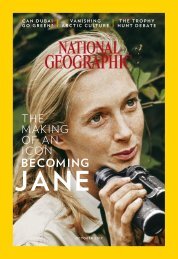NC
Create successful ePaper yourself
Turn your PDF publications into a flip-book with our unique Google optimized e-Paper software.
eauty and tranquility. And as she would<br />
throughout her career, she described chimps by<br />
their personalities and the names she’d given<br />
them. She called Fifi “agile and acrobatic” and<br />
described Fifi’s older brother Figan as an adolescent<br />
who “feels he’s a little bit superior.” To a<br />
baby who was “just beginning to find her feet,”<br />
Jane had impishly given the name Gilka, after<br />
the National Geographic editor.<br />
And in describing the need to protect the<br />
chimps and prevent them from being shot or sold<br />
to circuses, Jane referred to David Greybeard, the<br />
trusting chimp who had opened the door to some<br />
of her most important discoveries.<br />
“David Greybeard … has put his complete trust<br />
in man,” she told the audience. “Shall we fail<br />
him? Surely it’s up to us to do something to ensure<br />
that at least some of these fantastic, almost<br />
human creatures continue to live undisturbed in<br />
their natural habitat.”<br />
Her presentation was a triumph, and a milestone<br />
in her emergence as a public figure—a status<br />
she didn’t start out seeking but was learning<br />
to manage to her advantage. It caught the attention<br />
of a National Geographic executive who was<br />
launching a television specials division. A good<br />
deal of the Gombe footage ended up in one of the<br />
division’s first prime-time broadcasts: Miss Goodall<br />
and the Wild Chimpanzees, with narration by<br />
Hollywood luminary Orson Welles.<br />
When Hugo and Jane first screened the finished<br />
film, they complained of its many inaccuracies.<br />
They found the Welles narration patently unscientific—and<br />
at Jane’s insistence, the script was<br />
partially rewritten.<br />
To this day, as she watches the film on the laptop,<br />
Jane points out flaws. That leopard wasn’t<br />
photographed by Hugo, it was stock footage.<br />
That scene isn’t in Gombe, it’s somewhere in the<br />
Serengeti. And when Welles begins a sentence<br />
with “After two months’ search in vain,” Jane<br />
cuts him off: “It wasn’t true that I didn’t see any<br />
chimps for two months. That’s an absolute lie.”<br />
The flaws seemed to matter only to Jane and<br />
Hugo; the film was a commercial success. The<br />
two hoped they might do another film project<br />
and have more creative control, but Geographic<br />
officials had other ideas. They wanted to do more<br />
with Jane and Gombe, but not necessarily with<br />
Hugo. Jane was their star; Hugo, an accessory.<br />
In the years after the filming at Gombe, Jane<br />
and Hugo took different paths. In 1967 Hugo<br />
and Jane welcomed a son, Hugo Eric Louis van<br />
Lawick, known by his nickname, Grub.<br />
With Jane’s work anchored in Gombe and Hugo’s<br />
filmmaking passion in the Serengeti, nearly<br />
400 miles away, the two grew apart. In 1974 Jane<br />
and Hugo divorced. In 1975 she married Derek<br />
Bryceson, a Tanzanian government official.<br />
By the time Grub was eight, he was living<br />
with his grandmother and attending school in<br />
Bourne mouth. Derek and Jane had been married<br />
for only five years when he died of cancer in 1980.<br />
After a career spanning four decades, Hugo died<br />
of emphysema in 2002.<br />
WHEN I INTERVIEWED Jane in Gombe, it had<br />
been 55 years since she’d climbed out of a skiff<br />
and onto a pebble beach there for the first time.<br />
In her mind’s eye she can see things as they were<br />
then, from that beach up to the high ridge known<br />
as the peak: “It’s like another life, so long ago.”<br />
She can even watch herself pretending, and<br />
today recount it with a smile.<br />
In the film footage, Jane sees her 28-year-old<br />
self seated on the peak. It’s magic hour, nightfall.<br />
Hugo’s exposure is perfect. On screen, Jane pulls<br />
a blanket around her shoulders. She raises a tin<br />
cup to her mouth and sips.<br />
Now it’s Jane who’s the narrator.<br />
“That cup is empty, I swear,” she says. “There’s<br />
nothing inside it.” j<br />
“A PECULIAR WHITE APE”<br />
That’s how Jane thought the chimps regarded her:<br />
<br />
<br />
<br />
<br />
co-founder of Market Road Films, a production company<br />
based in New York. For National Geographic, he has<br />
<br />
GETTY IMAGES



